[Series] FESCARO's Automotive Cybersecurity FAQs
FESCARO has been operating the ‘FAQs
Series’ to address cybersecurity issues for stakeholders in the automotive
industry. We have conducted live webinars on four key topics, and the expert
panel from FESCARO provided answers to the most commonly asked questions from
industry professionals. If you missed a webinar on a topic that interests you,
you can access both the recorded video and a text summary (FAQs) at the
following link.
#
FAQs Series
1. Cybersecurity Strategies for Tiers (Emerging-OEMs oriented)
2. Comprehensive Guide on Cybersecurity Solutions & Engineering
3. Cybersecurity Testing method based on VTA Success Stories
4. ECU Cybersecurity guidance : From production to post-mass
production
5. How Korea’s Motor Vehicle Management Act Amendment impacts OEMs and Tiers
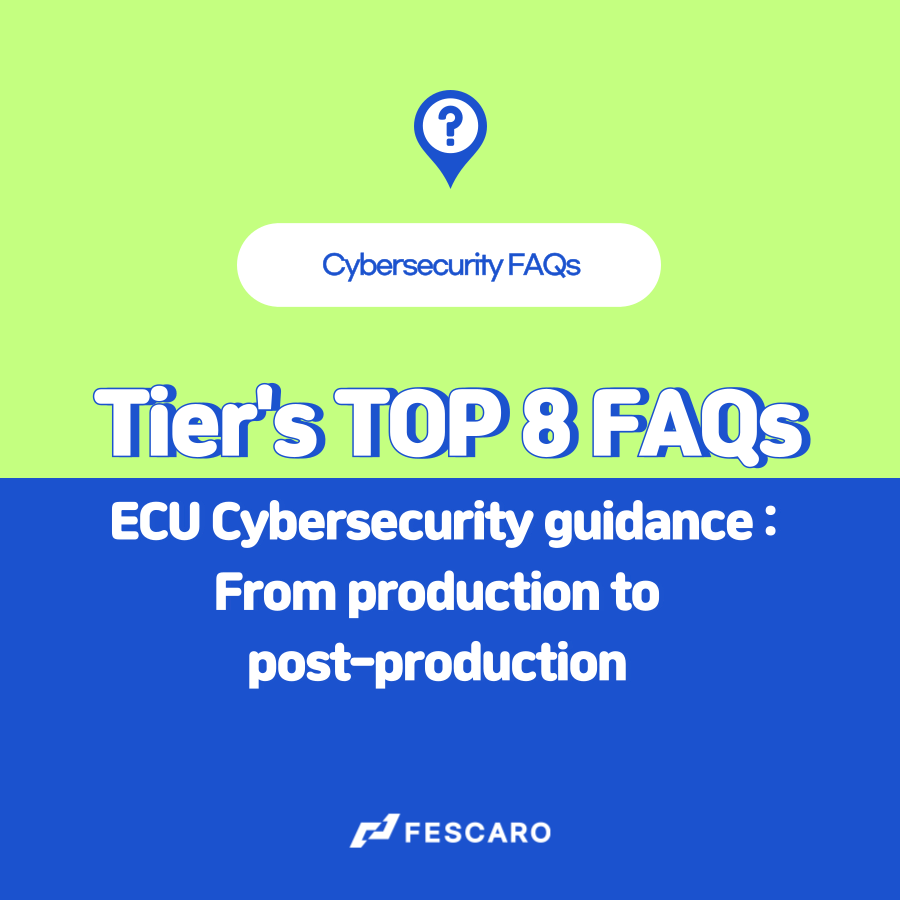
The last webinar of the year organized by FESCARO was successfully
completed. This webinar, titled <ECU
Cybersecurity guidance : From production to post-mass production> took
place on October and attracted approximately 80 participants from more than 50
companies.
Automotive controller developers should not only apply security solutions
to their controllers, but also consider cybersecurity during and after the
production. This webinar focused on both the KMS (Key Management System) required
during production and the Security
Control System required
on the post-production phase. Let’s
check out the clear answers from the FESCARO’s expert panel.
■ Expert Panels
• Director Ku Seong-seo & Team Leader Choi Hee-sun : 20+ years of experience in
embedded system SW development, including automotive controllers and security
solutions
• Director Lee Hyun-Jeong: A white hat hacker who is a question setter for 'CODE GATE CTF', an international
hacking defense competition, and an IT/Automotive security expert.
■ QUESTION LIST
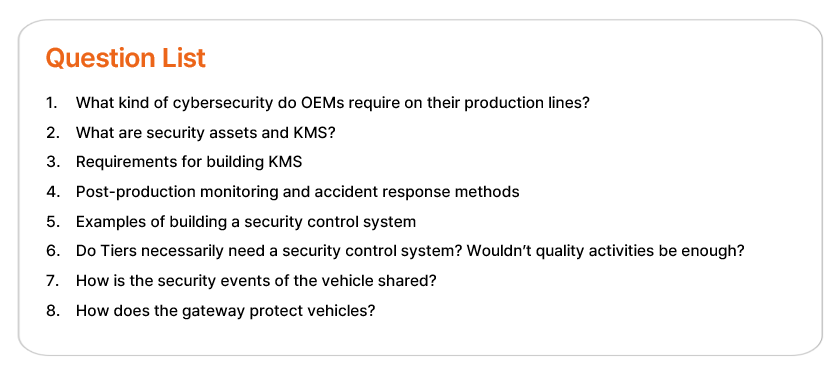
■ Video Ver.
■ Text
Ver.
1. What kind of
cybersecurity do OEMs require on their production lines?
Typically, OEMs rarely explicitly request cybersecurity-related
precautions for manufacturing controllers. This is due to the variations in
controller characteristics, semiconductor types, required security functions
for each controller, and the assets that need protection.
From the supplier's perspective, it is crucial to establish an
appropriate response strategy as they must effectively address these vague
requirements. When automotive cybersecurity requirements are unclear, it is
advisable to consult the international standard ISO/SAE 21434. The key is to
develop a rational and consistent response plan tailored to the specific
controller characteristics while aligning with OEM requirements.
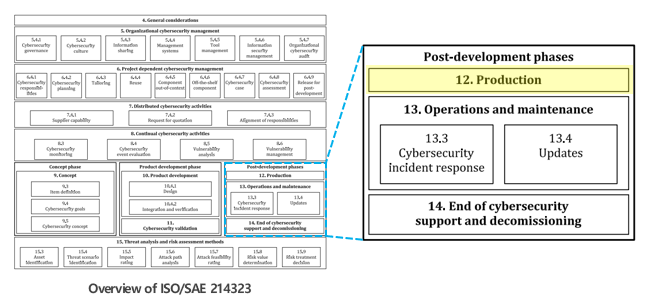
The table provides a summary of ISO/SAE 21434 in its entirety. Section 12
outlines the requirements that need to be considered when manufacturing controllers
or vehicles. It establishes two primary objectives: first, the application of WP-10-02,
which outlines the requirements that must be met during production after
development phase, and second, the prevention of new vulnerabilities from
entering the controller during production process. These requirements can be
broken down into in three key aspects: the establishment of a robust control
plan for production, the inclusion of four specific conditions within the production
control plan, and the successful execution of production in accordance with this
plan.
WP-10-02, which pertains to the
requirements on the production process after development includes the initialization
actions such as safely injecting and activating security assets (e.g.
encryption keys, passwords, certificates, etc.) used in the operation of the
security solutions so that the cybersecurity solutions or controllers can
operate properly in the vehicle after production.
The production Control Plan, mentioned in RQ-12-02, should include :
a. Procedure to meet the production requirements described above
b. Description of tools or equipment to be used for this purpose, e.g.
KMS, key injection device, verification device, etc.
c. Measures to keep the production environment safe (e.g. firewall, VPN,
etc.)
d. Measures to ensure reliable and proper fulfillment of production
requirements
We looked in more detail on WP-10-02 and the four key components that
must be incorporated within the Production Control Plan. In summary, two things
are essential for meeting OEM’s cybersecurity requirements: One is to safely
apply and activate security assets during the production process so that the
cybersecurity measures applied to the controller can function effectively
post-production, and the other is to provide environmental factors so that this
process can be sufficiently protected from external intrusions.
2. What are security
assets and KMS?
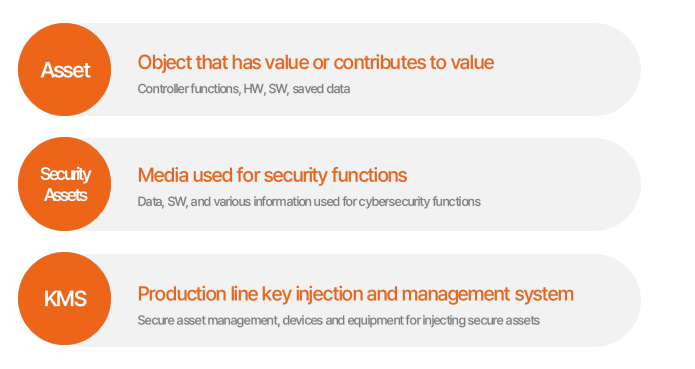
To help you understand, let me begin by explaining the terms. An asset is
something that requires protection since it possesses inherent value or
contributes to the overall value. In the context of a controller, assets
encompass controller functions, hardware (HW), software (SW), and the data
stored or utilized within the controller. The security assets mentioned in the
question refer to data, software, and various information used for
cybersecurity functions. These are also critical assets that need to be
protected.
Moving on to KMS (Key Management System), it refers to a device or
equipment responsible for generating, securely storing, and managing security
assets used in the controller's security functions. Additionally, it
facilitates the distribution and injection of security assets into the
controller during the production process. For those who may not be familiar
with KMS, I will provide a more detailed explanation.
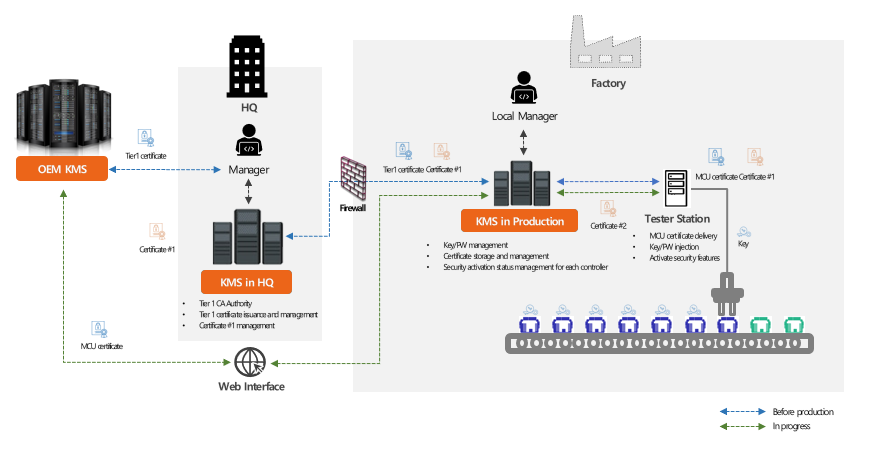
The diagram above illustrates the process of applying security assets,
whether provided by OEMs or independently created, to controller production. In
total, there are three Key Management Systems (KMSs), all of which are
responsible for managing security assets, such as certificates and security
keys, and distributing them as needed. For instance, OEMs create, distribute,
and manage security libraries or other keys required for security functions at
the request of suppliers request. The suppliers, in turn, receive, manage, and securely
maintain these assets, incorporating them into production when required. The controller
suppliers themselves have to generate essential security keys, passwords, and
other components, inject them into the controller, and activate the security
functions, and collect, manage the information to be used when needed.
Therefore, it is crucial to understand the OEM's requirements, identify the assets integrated into the controller, and make informed decisions regarding the configuration of the KMS and related processes. This necessitates professional judgment grounded in expertise and experience.

FESCARO possesses a track record of
constructing and delivering Key Management Systems (KMS) for OEMs. The KMS incorporates
processes to create/distribute/manage security assets necessary for OEMs to
cooperate with suppliers, and to carry out tasks appropriate to each role
within the organization.
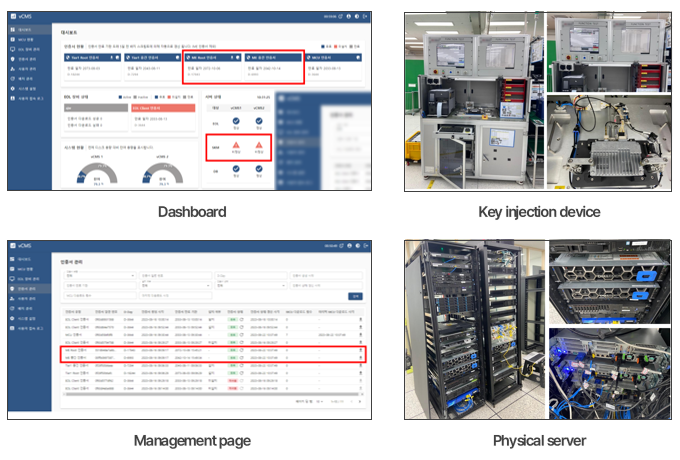
The KMS developed for suppliers was tailored to suit the unique
attributes of both the controller and the supplier, and it was seamlessly
integrated with the production line. Furthermore, we furnished a key injection
system that interfaces with both the KMS and the controller during the actual
production phase, allowing for the injection of security assets. Additionally,
we have frequently created and supplied software (SW) capable of receiving
these assets from the controller, securely storing them, and triggering
security functions when needed.
3. Requirements for building
KMS
When selecting a Key Management System (KMS), it is vital to understand
its intended purpose, namely, what data will be generated, managed, and
distributed. This can differ significantly between various OEMs and controller
types. This discussion outlines the fundamental factors that should be taken
into account when dealing with KMS, even when their specific purposes may vary.
Two key considerations must be addressed when developing KMS.
1. The robustness and reliability of the security assets generated by KMS
need to be upheld.
2. The environment where the KMS is located must be very safe from
external access.
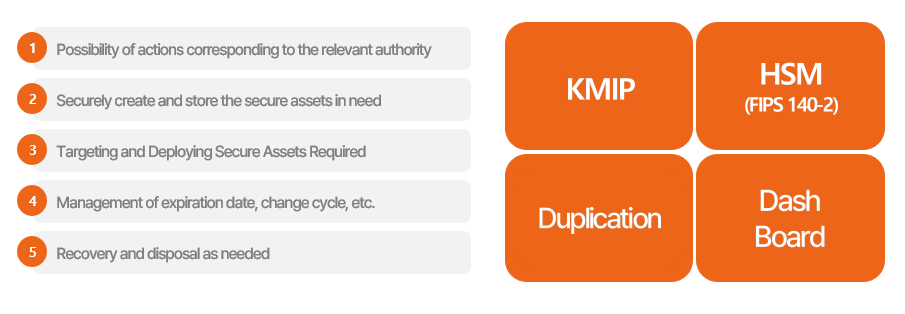
First, to ensure the robustness and reliability of security assets, it is
imperative that only authorized individuals have the capability to execute
actions in accordance with their granted permissions. The security assets
should be created and stored securely, and the recipients requiring these security
assets must be accurately specified to ensure precise distribution. Moreover,
effective management of their expiration dates and change cycles is essential,
and they should be restored or disposed of as necessary.
We will express the above five
requirements technically so that practitioners can understand them more easily.
We can assess compliance with the first condition by verifying whether the
system aligns with the Key Management Interoperability Protocol (KMIP). KMIP serves
as a client-to-server communication protocol utilized for the storage and
maintenance of security assets, including security keys and certificates. The
second requirement involves the use of Hardware Security Module (HSM) certified
under FIPS 140-2 standards. This certification ensures the stability and
reliability of the security logic within the system. As for the third
condition, it's imperative to implement redundancy measures to protect the
created assets and prevent operational disruptions. Lastly, the system should offer
support for functions such as dashboards, enhancing convenience in terms of
management and operations.
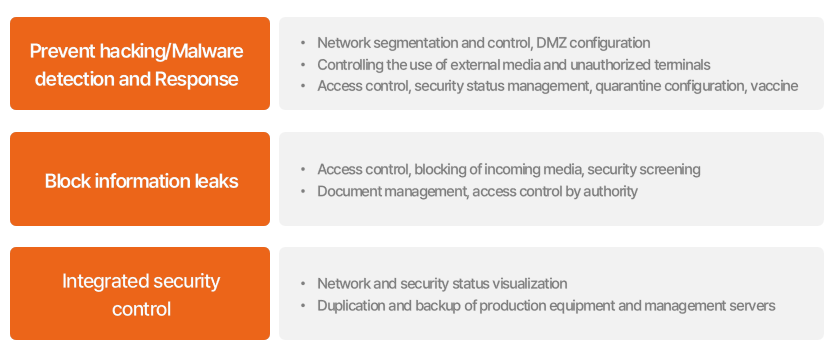
First, to ensure the robustness and reliability of security assets, it is
imperative that only authorized individuals have the capability to execute
actions in accordance with their granted permissions. The security assets
should be created and stored securely, and the recipients requiring these security
assets must be accurately specified to ensure precise distribution. Moreover,
effective management of their expiration dates and change cycles is essential,
and they should be restored or disposed of as necessary.
We will express the above five
requirements technically so that practitioners can understand them more easily.
We can assess compliance with the first condition by verifying whether the
system aligns with the Key Management Interoperability Protocol (KMIP). KMIP serves
as a client-to-server communication protocol utilized for the storage and
maintenance of security assets, including security keys and certificates. The
second requirement involves the use of Hardware Security Module (HSM) certified
under FIPS 140-2 standards. This certification ensures the stability and
reliability of the security logic within the system. As for the third
condition, it's imperative to implement redundancy measures to protect the
created assets and prevent operational disruptions. Lastly, the system should offer
support for functions such as dashboards, enhancing convenience in terms of
management and operations.
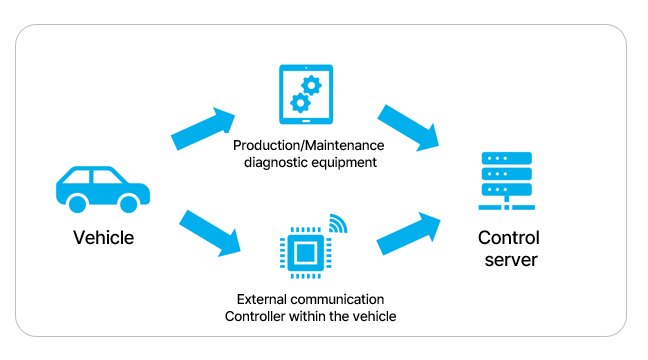
Usually, as part of quality activities, a process for managing security
events is defined and operated according to a manual. However, today we will
focus on collecting and managing security events that occur in the field.
FESCARO is constructing security event monitoring systems for clients
across the entire vehicle life cycle. The security event monitoring function is
initially activated during the vehicle production on the assembly line. At this
stage, details such as the software (SW) and hardware (HW) version information
installed on the vehicle, and the occurrence of security events, are recorded
on the server.
Once the security event monitoring function is initiated on the
production line, the Central Gateway (CGW) is tasked with collecting and
storing data regarding security events for controllers equipped with
cybersecurity functions within the vehicle.
Subsequently, when a manufactured vehicle is brought to a repair shop for
maintenance, diagnostic equipment is employed to ascertain whether any security
events have transpired in the vehicle. In the event of a security event, the
security log is gathered and transmitted to the server to update the vehicle's
status.
In cases where a security event occurs in a connected vehicle equipped
with an external communication controller, the controller communicates a
security event notification to the server. The server can, if necessary,
request comprehensive data from the vehicle for further analysis. Upon
receiving such a request, the vehicle transmits detailed data, including CAN
messages before and after a security event, to the server.

Upon receiving a security event that has transpired in a vehicle through
the three pathways previously described, the server undergoes an automatic
process to determine the vehicle model, controller, and software (SW) in which
the security event occurred. The server automatically categorizes the array of
security events obtained from diverse vehicles, facilitating an environment
where individuals can carry out their respective analysis tasks. The server may
encounter security events of a type that it cannot classify. In such instances,
these events are labeled as "Unknown" to enable human analysis.
Next, one or more security events that are related to each other are
grouped and managed as one security vulnerability. For example, security events
identified as abnormal messages by CAN-IDS are amalgamated into a singular
security vulnerability and collectively managed until the security
vulnerability is resolved.
Lastly, abnormal vehicles are managed. The status of each vehicle
produced on the production line is recorded, and this status is continually
updated through maintenance and connectivity activities. During this process,
not only the vehicle that reported the security event but also those vehicles
with a potential risk of encountering a similar security event are identified.
This proactive approach enables preemptive measures to be taken, enhancing
overall security.
5. Examples of building a security control system

FESCARO has successfully developed and maintained security control systems for global passenger and
commercial automakers. The image above illustrates the security control system we've implemented for a
global OEM. While there are numerous functions within the system, we will
introduce some of the key features.
First, let's discuss the dashboard. The dashboard provides a concise
overview of the current security event status. It offers real-time updates on
which security events have occurred in specific vehicles and compiles
statistical data. This data includes insights into which security events on
which vehicle type have been most frequent. It also includes a highly regarded
feature among OEMs: the ability to 'Download as Report.' This feature generates
reports detailing the status of security events, organized by month, week,
vehicle type, and individual vehicle, all conveniently presented in Excel
format.
Next, we have a feature that allows to examine the status of security
events in greater detail. It displays information about which events occurred
on which vehicles, along with their timestamps, event specifics, and any
mitigation actions taken. To simplify the analysis of raw data, this feature
visualizes and presents CAN messages.
Furthermore, the system provides a timeline of security events for a
specific vehicle. This timeline aids in easily assessing which security events
have taken place in a given vehicle. Importantly, the security control system goes beyond merely
collecting security events from the field; it streamlines and visualizes tasks
that would otherwise require manual handling, reducing the workload for human
operators. Feedback from our customers attests to the convenience and efficiency
that the security control system brings to the analysis
process.
6. Do Tiers necessarily
need a security control system? Wouldn’t quality
activities be enough?
Of course, we can manage security events through quality activities. However,
there are practical limitations to manual management, especially for Tier
suppliers who often work with multiple OEMs and their various vehicle variants.
Instead of manually classifying and analyzing every security event, the
adoption of a security control system can significantly enhance
efficiency.
While security control systems may not be mandated for
Tiers, an impact analysis process is crucial. A single
security event may potentially affect multiple vehicles and vehicle types. Security control systems automatically conduct impact analysis and identify vehicles that
haven't encountered a security event yet but are at risk, enabling proactive
measures to prevent the propagation of damage resulting from security
incidents.
Vehicles become increasingly interconnected with external networks and
hackers' attack strategies continuously evolve. What may be cutting-edge
security technology for controllers today may not be so in 10 or 20 years.
Given that no security system is entirely foolproof, ongoing monitoring after
production is essential. Rapid identification and analysis of security
incidents, followed by appropriate mitigation actions, are vital.
To achieve this, an appropriate security control system must
be introduced to protect against security threats throughout the vehicle's
entire life cycle.
7. How is the security
events of the vehicle shared?

Security events that can occur in vehicles include intrusion detection
events, software tampering events, and secure storage tampering events etc.
When these events occur, related information is collected and stored.
In the case of connected vehicles, security event data is instantly
relayed to a controller equipped with a telematics unit, such as a CCU. The
contents of security events and related information are gathered by the CCU and
then transmitted to the server. However, since connected services are optional
for vehicles, not all vehicles transmit security event data to the server in
real time.
For vehicles that are not connected, there is currently no direct means
to send security events to the server in real time. Nonetheless, the collection
of security events from as many vehicles as possible is essential for
addressing and preventing potential security incidents in the future.
To address this, non-connected vehicles rely on car repair shops to carry
out this task. When a vehicle is brought to a repair shop and connected to
diagnostic equipment, the diagnostic tools search for stored security events
within the vehicle's gateway and subsequently transmit this information to the
server. FESCARO is also actively developing and delivering a security solution
for diagnostic equipment to facilitate the search and automated transmission of
security events from the gateway to the server.

Let's explore the details of the security event information transmitted
to the server. In paragraph 7.2.2.2 of UN Regulation 155, the regulation
doesn't specify the exact information to be managed. However, it does emphasize
the need for a process to provide relevant data to support the analysis of
attempted or successful cyberattacks. This process must be in operation and
proven during the certification process.
To establish effective preventive measures, it is crucial to utilize
security event information to understand the nature of intrusion attempts,
identify issues, and pinpoint the timing of such events. Therefore, the
necessary information must be collected for analysis.
The information sent to the server includes the Vehicle Identification
Number (VIN) to determine which specific vehicle the security event occurred in,
the type of security event, a timestamp to track the time it occurred, and, a freeze frame (for intrusion detection
events) containing the CAN messages that were involved in triggering the event.
8. How does the gateway
protect vehicles?

The gateway maintains vehicle security
with the following functions:
1. Primary defense against intrusion attempted through the OBD diagnostic
port connected from outside the vehicle
2. Monitoring abnormal behavior of vehicle controllers and reporting
detected abnormal operations to the server
3. Detecting the operation of unauthorized software other than officially
certified software through the VTA certification process and reporting it to
the server
Let's begin by examining the concept
of 'defense against intrusion from outside the vehicle'. Indeed, this concept
is about shielding the vehicle from external intrusions that might occur through
a diagnostic port with an external contact point. This protection is achieved
by implementing security measures such as Secure Unlock, Secure Access, Secure
Flash, etc. For more about security features, please refer to the ‘Comprehensive
Guide on Cybersecurity Solutions & Engineering’ FAQs.
Second is about CAN-IDS, which upholds
vehicle security by focusing on the ‘detection and reporting of abnormal
behavior occurring inside the vehicle’ as specified in UN R155. This
encompasses the following six key activities:
· Undefined message detection
· Undefined signal detection
· Abnormal DLC message detection
· Abnormal cycle message detection
· Bus load detection
· Signal rate of change detection
In the development of a gateway, CAN
messages or signals are typically routed and processed according to a CAN DBC.
The CAN-IDS function comes into play when a message is received that is not
defined in the CAN DBC or when the signals fall outside the specified range. It
is also utilized when the length of the actual message received differs from
the DLC defined in the DBC or exceeds the defined cycle.
Expanding on this functionality, the
CAN-IDS can detect as abnormal conditions if it exceeds the defined range which
the bus load of the CAN network defined and gets overloaded or if signals that
should change gradually, such as RPM or vehicle speed, exhibit rapid and irregular
changes. However, it's important to clarify that the gateway primarily detects and
reports abnormal behavior rather than immediately implementing defense
mechanisms. This is because vehicles operate on a broadcast CAN network, making
it exceedingly challenging to identify the specific controller responsible for
an abnormal operation. Attempting to immediately control the problematic
controller can be hazardous during driving. Therefore, the current approach
involves detecting abnormal behavior, reporting it to the server, and
subsequently addressing the issue through software modifications and updates to
ensure safety.
Last is the 'detection of unauthorized software.' As previously discussed
UN Regulation 155, we will now introduce UN Regulation 156, known as the
Software Update Management System (SUMS). The gateway plays a vital role in
maintaining vehicle security by guaranteeing that only safe and authorized
software updates are applied and operated. This is achieved through a database
that manages software and hardware versions, compatibility information, and
other relevant data, which is linked to vehicle type certification and referred
to as RxSWIN for all controllers within the vehicle.
UN R156 requirements:
· 7.1 : Identify
hardware and software versions and component information and check software
integrity
· 7.2 : Identify software (RxSWIN)
related to Vehicle Type Approval (VTA) and check update compatibility;
· 7.2.1.1
: Protect and prevent
damage of the authenticity and integrity of software updates, and prevent
invalid updates
· 7.2.2 : Ensure safe
execution of updates and demonstrate that vehicle users are aware of updates.
The gateway plays a crucial role in ensuring that only software specified
in the RxSWIN DB can be updated. It also verifies the integrity of the software
to guarantee secure execution during the updating process, utilizing methods
such as Secure Flash.
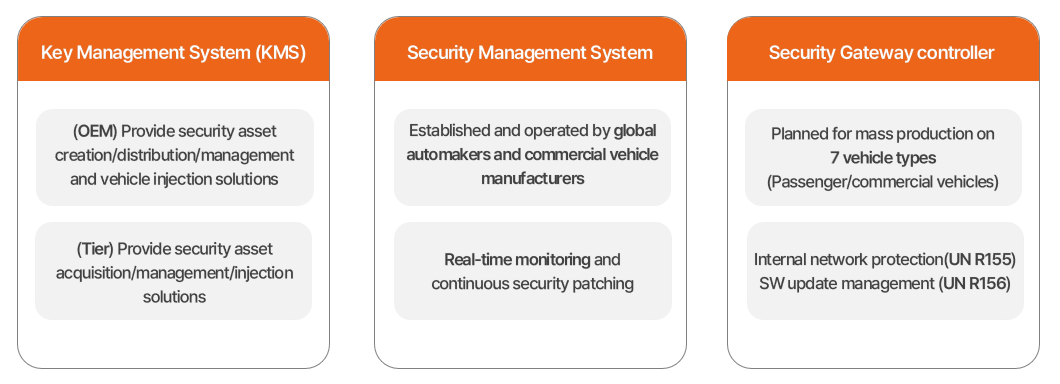
FESCARO has proven outstanding capabilities in key management systems
(KMS), security control systems, and security gateway
controllers. For key management systems, we have provided security asset
injection solutions to OEMs and Tiers. Additionally, we have developed and
maintained security control systems for leading global automakers
and commercial vehicle manufacturers. FESCARO's security gateway controller,
encompassing development on both software and hardware, is employed in
approximately seven vehicle models, including both passenger cars and
commercial vehicles, recognizing for its reliability.
If you encounter challenges in meeting OEM cybersecurity requirements or
face cybersecurity difficulties on production and post-production phase of
controllers, please contact the FESCARO’s ‘Security Counseling Center'. Together,
we can collaborate to identify and implement solutions to address your specific
cybersecurity needs.
■ Webinar Reviews
* Cheol Lee "I hope that more specific and honest webinars focusing on cases like this continues. I was impressed by the difference from other webinars."
* Hoon Noh “I think FESCARO's guidelines are a good strategy to respond to OEMs. It was beneficial as I had no experience communicating with OEMs.”
* Ki Song “The issues our company was concerned about were covered well, and it was especially helpful to my business as it was a Q&A related to practical work.”
* Kyo Jeong "I was curious about the security control system for monitoring and incident response after mass production, and it was easy to understand with actual application examples."
* Seok Go "I liked that it went beyond controller security, such as production lines and security control. There was a lot of new content that couldn't be found anywhere else."
* Mi Seung "It was good that production and post-production responses were also covered, and that the issues tiers were concerned about were explained from the OEM's perspective."
* Cheol Kang "The talk format was refreshing. It was interesting to hear things I was curious about before but found it difficult to ask questions about openly."
* Jun Lee "The TALK with the host and panelists was outstanding. I would like to hear about the cybersecurity system and preparations for SDV in future webinars."